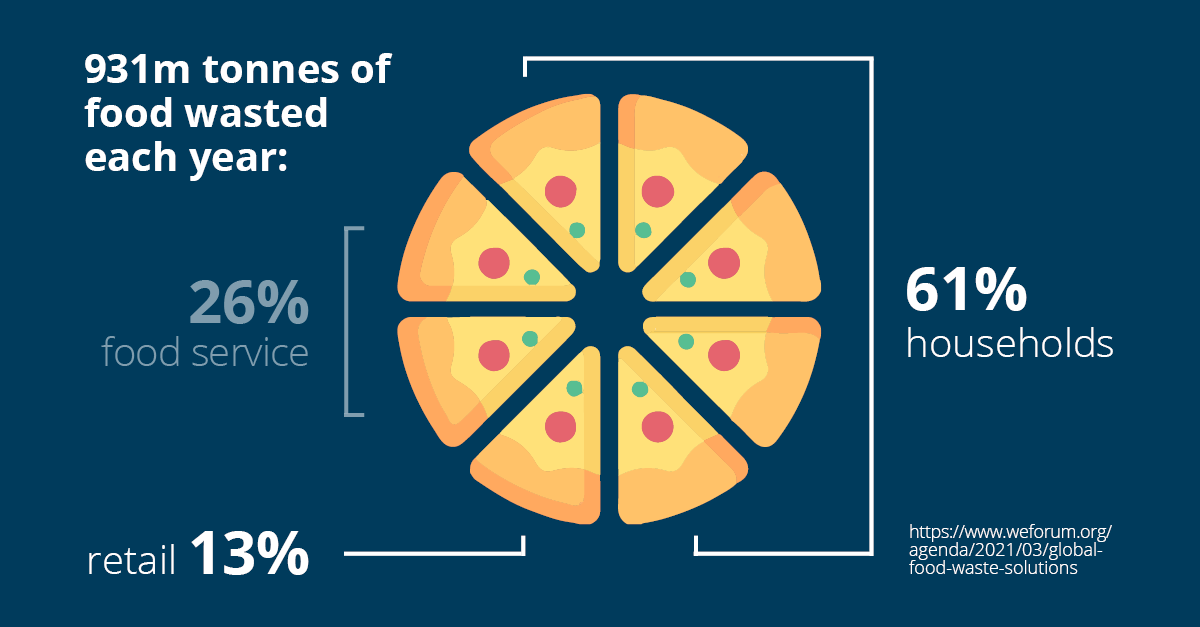Globally, we produce enough food to feed 10 billion people, yet hunger remains a pressing issue. Annually, approximately 931 million tonnes of food go to waste after production and processing. Out of this, 569 million tonnes (61%) is discarded by households, and 118 million tonnes (13%) is wasted by retail sources[i].
Addressing food waste is a fundamental aspect of sustainable development and the battle against climate change. Consequently, the UN Sustainable Development Goals have set a target to reduce food waste by half by 2030[ii]. However, achieving this goal will necessitate substantial investments at all stages of the value chain.
In this blog post, we will explore the potential role of 2D codes in mitigating food waste at the consumer and retail levels. These codes can provide additional information about the whereabouts and age of food products, aiding in this critical effort.

How to optimise inventory management with the help of 2D codes
In our previous blog posts, we’ve explored the role of 2D codes in helping brands gain deeper insights into their products and enhancing the customer experience by offering more information about their goods and services. However, the advantages of 2D codes extend beyond this.
Unique and batch-specific 2D codes can be embedded with data to establish links between physical products and their supply chains. This empowers brands to collect and share information, trace products, and manage recalls.
While other connectivity technologies, such as RFID tags, offer similar benefits, 2D codes represent one of the most practical solutions available today. Creating and printing 2D codes is cost-effective and straightforward, and the technology required for scanning and accessing data is widely accessible and well-established.
At the retail level, incorporating product expiration data into 2D codes offers a solution for enhancing inventory management. Retailers can monitor the quantity of saleable stock on the shop floor and in the warehouse, promptly removing items from shelves that have passed their expiration date.
Inventory management can be a laborious and time-consuming task, but with the assistance of 2D codes, it can be carried out more rapidly and efficiently. Additionally, it enables businesses to dynamically adjust the pricing of specific product batches, a topic we will explore further in the following sections.
What is dynamic pricing?
Dynamic pricing, also known as algorithmic pricing, is a pricing strategy that adapts to market changes. It involves the use of algorithms to determine the price of a product or service.
E-commerce often employs dynamic pricing, where companies lower prices during periods of low demand and raise them when demand is high. It can also be used to entice consumers to purchase products or services they have viewed but not bought by offering price discounts to encourage a sale.
In brick-and-mortar stores where 2D codes are utilized for inventory management and at the point of sale (POS), dynamic pricing systems can be employed to encourage consumers to purchase products approaching their expiration date. While a standard linear barcode only enables a POS system to retrieve a universal product code (UPC), a 2D code can link to more detailed product information, allowing retailers to adjust prices for specific product batches.
Incorporating batch-level information into scannable POS codes enables retailers to update prices for particular batches to stimulate purchases. This approach benefits both sustainability and profitability: retailers reduce food waste by selling products rather than discarding them, while also enhancing profit margins.
In recent years, several retailers, such as Woolworths in Australia, and Meny in Norway and Denmark, have experimented with dynamic pricing models using date-containing 2D codes on their own-brand products. Third-party providers have also emerged to offer dynamic pricing infrastructure, including shelf labels and POS systems. An example is Wasteless, an Israeli startup that utilizes expiration dates and stock data to calculate the optimal product price in real-time, embedding product data within a 2D code.
What is the benefit for consumers?
Incorporating additional information within 2D codes also brings advantages to end consumers. With dynamic pricing models, as described earlier, consumers can enjoy more competitive pricing and discounts on products with shorter shelf lives.
Moreover, research indicates that consumers are increasingly open to scanning 2D codes to access product information. A recent study conducted by Cornell University explored the replacement of traditional date codes on milk with scannable QR codes that provide a best-before date when scanned using a smartphone. During the two-month study, over 60% of customers chose milk with the QR code over products with conventional best-before dates[vi].
Integrating products with 2D codes also opens up opportunities for further applications in the Internet of Things (IoT) and integration with smart home systems. Smart refrigerators and personal assistants equipped with technology to retrieve information from scannable 2D codes – or from shopping data obtained directly from the retailer – could use this data to maintain a household inventory, generate meal plans, and provide tips to reduce food waste.
While this may sound futuristic, forward-thinking tech companies are already introducing smart home systems to help consumers combat food waste. For example, in 2019, Samsung launched the Family Hub, a smart refrigerator featuring an internal camera designed to identify best-before dates on fresh produce and offer advice when food is nearing its expiration[vii].
Looking to the future
The advantages and importance of 2D codes are undeniable, encompassing a wide range of applications, including manufacturing execution, logistics and traceability, retail stock management, and consumer awareness. If you haven’t yet considered the role that 2D codes could play in your business, the time to start is now, as your competitors are likely already making strides in this direction.
At Codico, we are dedicated to assisting brands in preparing for a future where all products and packaging are equipped with 2D codes. Please don’t hesitate to contact us to learn more or to consult with an expert regarding the most suitable solution for your specific requirements.
[i] https://www.weforum.org/agenda/2021/03/global-food-waste-solutions.
[ii] https://www.fao.org/sustainable-development-goals/indicators/1231/en/
[iii] https://www.gs1ie.org/standards/data-carriers/intelligent-barcodes/case-studies/
[iv] https://www.matvett.no/bransje/matvett-in-english/expiry-date-included-in-barcode-reduces-food-waste
[v] https://news.cornell.edu/stories/2022/06/consumers-embrace-milk-carton-qr-codes-may-cut-food-waste

